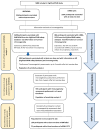Association between Reactogenicity and Immunogenicity in a Vaccinated Cohort with Two mRNA SARS-CoV-2 Vaccines at a High-Complexity Reference Hospital: A Post Hoc Analysis on Immunology Aspects of a Prospective Cohort Study
- PMID: 38932394
- PMCID: PMC11209257
- DOI: 10.3390/vaccines12060665
Association between Reactogenicity and Immunogenicity in a Vaccinated Cohort with Two mRNA SARS-CoV-2 Vaccines at a High-Complexity Reference Hospital: A Post Hoc Analysis on Immunology Aspects of a Prospective Cohort Study
Abstract
Enhancing our comprehension of mRNA vaccines may facilitate the future design of novel vaccines aimed at augmenting immune protection while minimising reactogenic responses. Before this design is carried out, it is important to determine whether adaptive immunity correlates with the reactogenicity profile of vaccines. We studied a large cohort that was vaccinated with mRNA vaccines to answer this question. This was an observational study with real-world data. Reactogenicity data were obtained from the VigilVacCOVID study. Immunogenicity (humoral and cellular) data were retrieved from health records. One main population (n = 215) and two subpopulations were defined (subpopulation 1, n = 3563; subpopulation 2, n = 597). Sensitivity analyses were performed with subpopulations 1 and 2 to explore the consistency of results. We analysed the association of the intensity and types of adverse reactions with the development and quantity of elicited antibody titres. As an exploratory analysis in subpopulation 1, we assessed the association between reactogenicity and cellular immunogenicity. A higher incidence of fever, malaise, and myalgia including severe cases was significantly associated with the development and quantity of positive antibody titres. No significant findings were observed with cellular immunity. We observed a positive association between immunogenicity and reactogenicity. These findings can be relevant for the future development of our understanding of how mRNA vaccines function.
Keywords: immunogenicity; mRNA vaccines; pharmacovigilance; reactogenicity; real-world data.
Conflict of interest statement
None of the authors have any conflicts of interest to disclose.
Figures




Similar articles
-
Evaluation of immunogenicity and reactogenicity of COVID-19 vaccines in pregnant women.Ultrasound Obstet Gynecol. 2022 Nov;60(5):673-680. doi: 10.1002/uog.26050. Ultrasound Obstet Gynecol. 2022. PMID: 36318630 Free PMC article.
-
Innate Responses to the Former COVID-19 Vaccine Candidate CVnCoV and Their Relation to Reactogenicity and Adaptive Immunogenicity.Vaccines (Basel). 2024 Apr 6;12(4):388. doi: 10.3390/vaccines12040388. Vaccines (Basel). 2024. PMID: 38675770 Free PMC article.
-
A multinational, phase 2, randomised, adaptive protocol to evaluate immunogenicity and reactogenicity of different COVID-19 vaccines in adults ≥75 already vaccinated against SARS-CoV-2 (EU-COVAT-1-AGED): a trial conducted within the VACCELERATE network.Trials. 2022 Oct 8;23(1):865. doi: 10.1186/s13063-022-06791-y. Trials. 2022. PMID: 36209129 Free PMC article.
-
Immune responses related to the immunogenicity and reactogenicity of COVID-19 mRNA vaccines.Int Immunol. 2023 May 8;35(5):213-220. doi: 10.1093/intimm/dxac064. Int Immunol. 2023. PMID: 36566501 Review.
-
Reactogenicity and immunogenicity of heterologous prime-boost immunization with COVID-19 vaccine.Biomed Pharmacother. 2022 Mar;147:112650. doi: 10.1016/j.biopha.2022.112650. Epub 2022 Jan 19. Biomed Pharmacother. 2022. PMID: 35066301 Free PMC article. Review.
References
-
- CDC Morbidity and Mortality Weekly Report (MMWR) [Internet] [(accessed on 7 June 2024)];2021 Available online: https://www.cdc.gov/mmwr/index.html.
-
- Faksova K., Walsh D., Jiang Y., Griffin J., Phillips A., Gentile A., Kwong J.C., Macartney K., Naus M., Grange Z., et al. COVID-19 vaccines and adverse events of special interest: A multinational Global Vaccine Data Network (GVDN) cohort study of 99 million vaccinated individuals. Vaccine. 2024;42:2200–2211. doi: 10.1016/j.vaccine.2024.01.100. - DOI - PubMed
LinkOut - more resources
Full Text Sources
Research Materials
Miscellaneous

